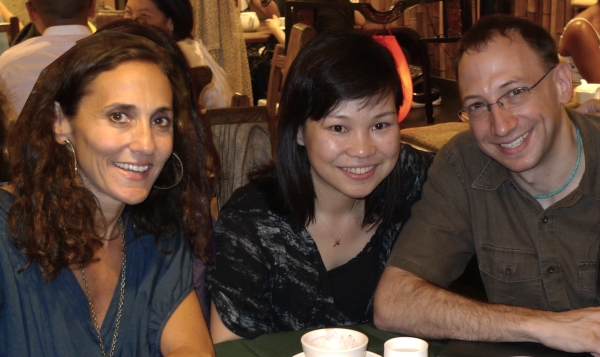The first book of its kind, Art Therapy in Asia documents how the field of art therapy is taking shape as both a profession and a discipline in this region, with art therapists assimilating Western models and adapting them to create unique home-grown practices.
In this interview, editors Debra Kalmanowitz, Jordan Potash and Siu Mei Chan discuss how art therapy differs in the East and West, and how their pioneering new book came about.

Can you tell us a bit about yourself and what attracted you to the field of art therapy?
DK: I came to art therapy by chance. I have always made art, and continue to do so. From early on remember feeling frustrated with words, feeling that when I put something into words, it seemed to loose its power and often its meaning. A combination of my love of the arts and an interest in psychology, sociology and anthropology brought me to art therapy.
JP: I have been an artist for as long as I can remember and I knew even in high school that I wanted to use art in the service of others. I feel fortunate that I found the field of art therapy, which allows me to combine these areas of being able to offer art for the betterment of individuals and communities.
SMC: I first experienced the power of art therapy by attending an Introduction to Art Therapy course in 2002. I was very impressed and touched by the group process. I experienced the art therapy process by using art as a tool for communication. At that time, it was a process of exploration and self- discovery. Then the devastating Tsunami disaster happened on 26 December 2004 (it was also my birthday), and it had a big impact on me. On TV I saw thousands of broken, helpless, grief-stricken faces, scarred from the loss of their loved ones. I started to think of the meaning of my career and life, and in the end it brought me to formal art therapy training.
This is the first book to examine the theory and practice of art therapy in a specifically Asian context. Why did you decide to compile and edit a collected volume on this subject and what is timely about its publication?
 The creative and expressive arts therapy are growing progressively across Asia. Some asian countries have already established formal art therapy training courses. Knowing that this is new and innovative, and at a crucial stage of development and growth of localisation characteristic in art therapy, it became clear to us that this was a topic that needed to be discussed and presented. When Hong Kong hosted the Asian Art Therapy Symposium in 2009, we saw some of the diverse ways that art therapy was being practiced in the region. This book is the first attempt to look at the issues specific to this part of the world, and to begin to share the work that is already paving the way for a new profession in the region. We purposefully chose the form of an edited book in order to allow for multiple voices, each of which can speak to a different facet of art therapy in Asia. When put together, these give us a greater sense of the practices and theories involved and that are evolving.
The creative and expressive arts therapy are growing progressively across Asia. Some asian countries have already established formal art therapy training courses. Knowing that this is new and innovative, and at a crucial stage of development and growth of localisation characteristic in art therapy, it became clear to us that this was a topic that needed to be discussed and presented. When Hong Kong hosted the Asian Art Therapy Symposium in 2009, we saw some of the diverse ways that art therapy was being practiced in the region. This book is the first attempt to look at the issues specific to this part of the world, and to begin to share the work that is already paving the way for a new profession in the region. We purposefully chose the form of an edited book in order to allow for multiple voices, each of which can speak to a different facet of art therapy in Asia. When put together, these give us a greater sense of the practices and theories involved and that are evolving.
What is the key difference between art therapy in Asia and in the West?
When we look at art therapy in Asia, we could say that there are as many differences as there are similarities. To suggest that there is one key issue would be to oversimplify the subject. The similarities lie in the use of the arts in healing, and the understanding that working through the arts holds tremendous capacity for transformation and change. There are of course numerous differences, all of them stemming from fundamental differences in culture as it relates to conceptions of health, relationships, therapy practices, belief systems and cultural attitudes towards the arts. This book goes into the intricacies of these differences and similarities in great detail. In editing this book and engaging with the authors, we came to understand more fully that difference is both an actuality and a fallacy. We hope that readers will not be lulled into a preconceived or stereotyped notion of art therapy in Asia as either unnecessarily “exotic” or ultimately the same, but rather as a practice firmly rooted in culture and values, like art therapy anywhere else in the world. This is why we chose the subtitle, to demonstrate that practices may have their core in Asia, whereas others may be rooted elsewhere. Either way, they still become fully “Asian”, demonstrating uniqueness and similarity at the same time.
Why was it important to include spirituality as a particular theme?
All of the sections in the book came about as we reviewed the dominant themes of the proposals we received from the authors. As we reviewed them, we were reminded how Buddhism, Taoism, Confucianism, and Hinduism form an integral part of the thinking and the moral make up of the region. Sometimes these major religions are connected to spirituality, but at other times the influence that they have is as a basic moral guide, a framework defining ethical behaviour by which to live. Whatever form they take, these religions are ever present. Numerous chapters that were submitted for this book included the use of spirituality explicitly in their work, and it was important therefore that these authors had a voice as part of the practice in the region.
In addition to this, there are numerous practices from the Buddhist tradition which have been adopted without the connection to spirituality or religion. Mindfulness, meditation and the holistic approach to the body – the connection between the body, mind and spirit. These approaches have been adopted not only in the East, but in the West, too. It is because of this that we have included a section on spirituality in the book that includes examples from Singapore, Thailand and Japan.
The book explores how Asian art therapists have adopted Western models, adapted them to suit their wide-ranging needs and contexts, and developed their own original approaches. In what ways are their practices now influencing Western practice?
There is a constant flow of information, a cross-germination of different ideas, a mixture of philosophies methods and outlooks in the world. This is happening across the board, and art therapy is no exception. There is no doubt that art therapists around the world will find resonance and inspiration from the theories and practices detailed in the book. More than simply adapting techniques, we hope they see the influence of culture and how art therapy in Asia provides new ways of working, but also opportunities to reflect and re-envision art therapy practice everywhere. There is no doubt that there is a flow between art therapists practicing in the East and West. Art therapists in Asia benefit from theories and practices developed in the West, just as those in the West draw on ideas and strategies from the East. One need only look at the allure of projective drawings in the East and the pull towards mindfulness in art making in the West. As a profession, art therapists on both sides will learn from each other.
What do you hope readers will take away from this book?
We hope that the readers will be able to read this book and reconsider their own work, no matter where they work. Although globalisation is often thought of as damaging to local culture, the spread of information gives us all ways to learn from each other. Considering the benefits of meditation, holistic health and collectivist values as they apply to art therapy provides an angle that is not reflected in other literature. Instead of looking for a new series of techniques or interventions, we hope that readers will discover fundamentally new ways of conceptualising both their work and how they work. So, while the book may be useful to those working in Asia, it can also prompt new ways of practicing art therapy more generally. Moreover, it details the influence and role of cultural-bound values that are inherent in theories and practices. This is applicable not only for art therapists in Asia, but all art therapists transporting art therapy across cultures.
Copyright © Jessica Kingsley Publishers 2012.
Debra great to read about your work. It seems important that you are adding to knowledge writing about art therapy in the East.
Keep up the good work. I m sure that Jonni, Adam and Giya are all proud of you as I am. Hope they award you a doctorate for this work.
Love Kenny
I would like to review this book for the Australian and New Zealand Journal of Art Therapy. did mention this intent to Jordan Potash some months ago. My interest is that I was the first Program Leader for the MA Art Therapy course in Singapore in 2006 and wrote on this subject for AATA conference panel. I currently run a one year training course for the Centre for Art Psychotherapy, amongst other short courses, and this publication will also be of interest to my students.
Annette Coulter